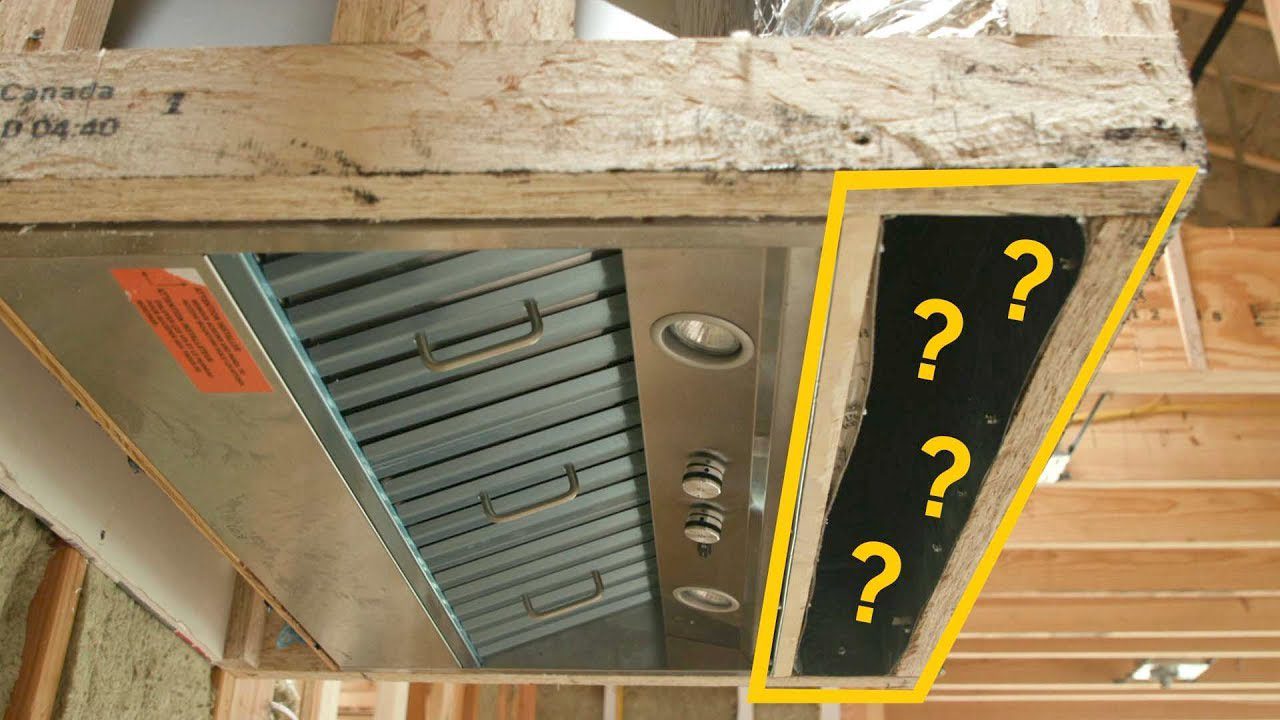When is Makeup Air Required for a Range Hood? Most range hoods are designed to work without the need for makeup air. However, if your range hood is vented to the outside and you have a high-efficiency furnace or sealed combustion water heater, you may need to provide makeup air to prevent negative pressure in your home.
Makeup air is required for a range hood when the home is not able to provide enough natural ventilation. This can happen when the home is too tightly sealed or when cooking fumes are especially strong. In these cases, a range hood that vents to the outside is necessary to ensure that cooking odors and smoke do not build up inside the home.
All About Make Up Air | This Old House
Do I Really Need Make Up Air for My Range Hood?
When it comes to range hoods, the answer to this question is a resounding yes! Make-up air is essential for two reasons: first, because range hoods work by pulling air from your kitchen and venting it outside, and second, because range hoods can create negative pressure in your home if they’re not properly ventilated.
Without make-up air, your range hood will have to work harder to pull air from your kitchen, which will decrease its efficiency and could cause it to overheat.
Additionally, negative pressure can lead to all sorts of problems like drafts, leaks, and even backdrafting of harmful gases like carbon monoxide.
So how do you ensure that your range hood has enough make-up air? The easiest way is to install an inline fan that’s connected to both the outlet side of your range hood and the outside of your home.
This way, the fan will constantly be pulling fresh air into your home and exhausting stale air out – keeping both yourrange hood and your home well ventilated.
What Size Range Hood Requires Make Up Air?
The size of the range hood is not the only factor that determines how much make-up air is required. The volume of air movement, the length of time that the range hood is operated, and the type of cooking being done all play a role in how much make-up air is needed.
Generally speaking, most homes need at least 100 CFM of make-up air for every 1,000 CFM of exhaust from the range hood.
So, if you have a range hood that moves 400 CFM of air, you would need at least 40 CFM of make-up air.
There are several ways to provide make-up air for a range hood. The most common method is to use an inline fan that is connected to the ductwork leading to the outside.
The inline fan will bring fresh air into the house and help to equalize the pressure so that there is enough airflow through the range hood.
Another option is to install a dedicated fresh air intake duct directly to the range hood. This duct would bring fresh air into specifically for makeupair purposes.
This option might be necessary if your home does not have enough existing ventilation or if you are using a very high powered range hood (1000+ CFM).
If you are unsure about what size or type of ventilation system you need for your home, it is best to consult with a professional who can perform a full analysis and help you select the right solution for your needs.
Is Makeup Air Necessary?
In short, the answer is yes – makeup air is necessary in many cases. Here’s a more detailed explanation:
There are two main reasons why makeup air is needed: to replenish the air that has been exhausted by mechanical ventilation, and to prevent negative pressure within a building.
If exhaust fans are used without providing an adequate amount of makeup air, it can create negative pressure within the building. This can cause problems such as doors and windows being difficult to open, outside contaminants being drawn into the building, and increased energy costs due to the HVAC system working harder than necessary.
Another reason why makeup air is important is because it helps to replenish the air that has been exhausted by mechanical ventilation.
This is especially important in commercial kitchens where exhaust hoods are constantly running to remove smoke and fumes. If there isn’t enough fresh air being brought in, it can create an unhealthy and dangerous environment for employees.
Overall, makeup air is essential for maintaining proper indoor air quality and preventing negative pressure within a building.
If you have any questions or concerns about your specific situation, be sure to consult with a professional HVAC contractor who can advise you on the best course of action.
How Far Does Make Up Air Have to Be from Exhaust?
Make up air is the air that is brought in to replace the exhaust air that is being removed from a space. The distance that the make up air needs to be from the exhaust will depend on the strength of the exhaust fan and the size of the space. If the exhaust fan is strong, then the make up air can be further away.
If the space is large, then more make up air will be needed and it will need to be closer.


Credit: www.finehomebuilding.com
Kitchen Hood Makeup Air Calculation
A kitchen hood is a device that is installed above the cooking area in order to remove smoke, fumes, and odors from the air. Kitchen hoods come in a variety of sizes and shapes, but all operate with the same basic principle: they use fans to draw air through a duct system and then release it outdoors.
The most important factor in choosing the right size kitchen hood is the amount of airflow that it can provide.
This is measured in cubic feet per minute (CFM), and you’ll need to know the CFM rating of your rangehood before you can select the proper size for your kitchen. To calculate the CFM needed for your rangehood, you first need to determine the volume of your kitchen. This can be done by measuring the length x width x height of your room in feet.
Once you have this number, multiply it by 0.5 to get your minimum CFM requirement.
For example, if your kitchen measures 10’x10’x8′, you would need a rangehood that can provide at least 400 CFM of airflow (10x10x8 x 0.5 = 400). It’s always better to err on the side of too much airflow rather than too little, so you may want to choose a rangehood with a higher CFM rating than what’s strictly necessary for your space.
Another important consideration when selecting a rangehood is its ability to properly ventilate makeup air back into the room. Makeup air is necessary anytime ventilation occurs – otherwise, negative pressure will build up inside your home and make it difficult for doors and windows to close properly. Most modern homes are designed with adequate makeup air already supplied to them through their HVAC systems, but if yours isn’t or if you’re not sure, it’s always best to consult with a professional before installing a new rangehood.
.
When selecting a new range hood for your home’s kitchen there are several factors which must be considered in order ensure both safety as well as peak performance from this important appliance; one such factor is cubic feet per minute or “CFM” requirements which depict how much volume (airflow) will be displaced by operation of said fan – meaning we must know how much power our chosen model packs before making our purchase!
How to Install Makeup Air for Range Hoods
Most homes are not equipped with makeup air for range hoods, which means that when you turn on your range hood, it’s pulling air from inside your home to exhaust the smoke and fumes. This can create a negative pressure situation inside your home, which can lead to all sorts of problems like drafts, backdrafting of appliances, and increased dust and pollen levels.
The good news is that installing makeup air for your range hood is relatively easy and inexpensive.
There are two main ways to do it: through the ductwork or with an inline fan.
If you have existing ductwork, the easiest way to install makeup air is to tie into that. You’ll need to consult with a heating and cooling professional to make sure that you’re doing it correctly and not introducing any new airflow issues into your home.
If you don’t have existing ductwork, or if tying into it isn’t possible or practical, you can install an inline fan. Inline fans are installed between the range hood and the outside wall, and they pull air from outside to make up for what’s being exhausted by the range hood.
Installing an inline fan is a bit more involved than tying into existing ductwork, but it’s still a relatively easy project that most homeowners can handle themselves.
Just be sure to read the instructions carefully and follow them exactly; otherwise you could end up creating more problems than you solve.
Makeup Air System for Range Hood
A makeup air system for a range hood is designed to bring fresh air into the kitchen when the range hood is in use. The system typically consists of an intake duct that runs from the outside of the house to the range hood, and a blower that helps to circulate the air.
There are several benefits to having a makeup air system for your range hood.
First, it can help to prevent odors from building up in the kitchen. Second, it can help to keep the air in the kitchen cooler, which can be helpful during hot weather. Third, it can help reduce condensation on surfaces near the range hood.
fourth, makeup air systems can prolong the life of your range hood by helping to prevent grease and other contaminants from build up on its filters.
If you are considering installing a makeup air system for your range hood, there are a few things you should keep in mind. First, make sure that you have enough space for all of the components of the system (intake duct, blower, etc.).
Second, consider whether you want a ducted or non-ducted system – each has its own set of pros and cons. Third, be sure to consult with a professional installer before making any decisions – they will be able to advise you on what type of system will work best for your home and your needs.
Conclusion
If your range hood doesn’t have an external exhaust, then it’s likely that you’ll need to provide makeup air for it. Makeup air is simply outside air that enters a building to replace the air that has been exhausted by the range hood. The amount of makeup air required will depend on the size of the range hood and the type of cooking being done.

